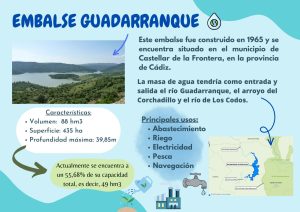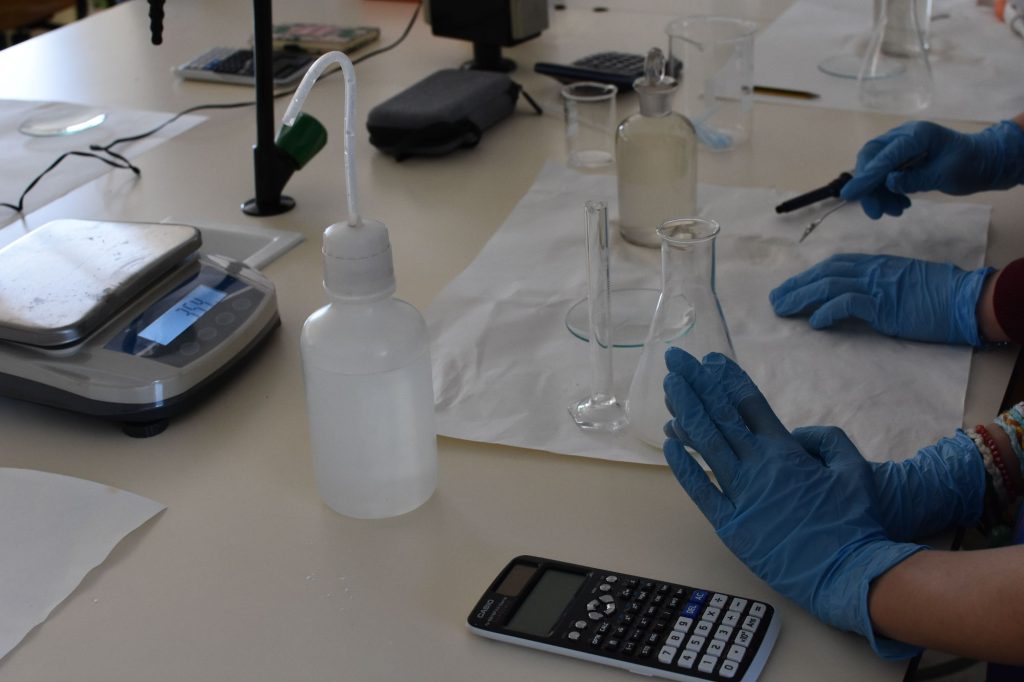Climate Detectives Projects 2022-2023
Project title: CRENEA: Water for Life
Team: G.I.P.I
Secondary School Carlos Castilla Del Pino San Roque Spain 12 Student’s age: 12-13 years old, 14-15 years old, 16-17 years old, 18-19 years old
What are the causes of the eutrophication problem in the Guadarranque reservoir, which supplies water to San Roque, and how does this problem affect us?
¿Cuáles son las causas del problema de eutrofización presente en el embalse de Guadarranque, del que se abastece de agua San Roque? ¿Cómo nos afecta este problema a nosotros?

Every time we turn on the tap at home or at school we have a precious and scarce commodity at our disposal: WATER. Of the reservoirs that supply our town, the Guadarranque reservoir is the largest, deepest and most northerly located, and the one that is under the most environmental pressure, mainly due to the urban centres, crops, livestock farms and, of course, the omnipresent industry in our region. We are aware of how insignificant our presence as people is in the water cycle, but the consequences that our way of life is having on the quality of water is enormous.
In our research we have focused on the eutrophication of the Guadarranque reservoir, we see the need to act because we are aware of the repercussions that this problem has on us, as citizens and as members of society. On the one hand, the quality of life and health of the population, not least the repercussions on the local economy and, above all: the suffering and disfigurement of our local ecosystems, which are part of the richness of our land and form part of our own unique identity in this globalised world.
In addition to the local studies on the uses and intensity of the same in the territory, and taking into account the availability of time, material and resources at our disposal, we set to work on designing, carrying out and discussing the results of chemical experiments to determine the concentration of dissolved oxygen in the body of water and the nitrate and nitrite content in the same, which are two of the fundamental parameters for determining the degree of eutrophication of a body of freshwater.
Cada vez que abrimos el grifo de casa o del instituto disponemos de un bien precioso y escaso: el AGUA. De los embalses que abastecen a nuestro pueblo, el de Guadarranque es el de mayor tamaño, mayor calado y situación más septentrional, y el que soporta más presión ambiental debido, fundamentalmente, a los núcleos urbanos, cultivos, explotaciones ganaderas y, como no, la omnipresente Industria de nuestra comarca. Somos conscientes de lo insignificante que es nuestra presencia como personas en el ciclo del agua, pero las consecuencias que está teniendo nuestra forma de vida en la calidad de la misma es enorme.
En nuestra investigación hemos puesto el foco en la eutrofización del embalse de Guadarranque, vemos necesario actuar debido a que somos conscientes de las repercusiones que este problema tiene sobre nosotros, como ciudadanos y como miembros de la sociedad. Por un lado, la calidad de vida y la salud de la población, no menos importantes son las repercusiones en la economía local y, sobre todo: el sufrimiento y la desfiguración de nuestros ecosistemas locales, que forman parte de la riqueza de nuestra tierra y configuran parte de nuestra propia e irrepetible identidad en este mundo globalizado.
Además de los estudios locales sobre usos e intensidad de los mismo en el territorio, y teniendo en cuenta la disponibilidad de tiempo, material y recursos que estaban a nuestra disposición, nos pusimos manos a la obra en el diseño, realización y discusión de los resultados de experimentos químicos para determinar la concentración de oxígeno disuelto en la masa de agua y contenido de nitratos y nitritos en la misma, que son dos de los parámetros fundamentales para determinar el grado de eutrofización de una masa de agua dulce.

We took the samples from the water body in a central position on the bank of the reservoir, guaranteeing its stability in order to preserve it in the best possible conditions. We set up five stations in the institute’s laboratory to test dissolved oxygen (“Winkler” method), nitrite content in the water body and pH with test strips; our intention was to have enough data to compare the results and determine our parameters as accurately as possible. The results showed values of 29.5 mg of DO in 300 ml of water mass, reaching values of 6.5 mg of nitrites per litre and 5 pcs of ph were measured in the water mass. The first two data suggest a HIGH degree of eutrophication of the water body, while the pH of the sample (slightly acidic) is below the permitted range for water for human consumption, which is between 6.5 and 9.5 pc (indicating a possible effect of atmospheric sedimentation, mainly from heavy industry).
Significant impacts are expected in the following areas:
Landscape: The sludge takes over the bottom of the reservoir due to the growth and putrefaction of plants and other organisms; gradually losing depth and generating a nauseating odour.
Economic: The requirement for chemical and biological treatments to make the water fit for consumption causes significant management costs. Likewise, the degradation of the landscape affects the tourism sector (hiking, sport fishing, aquatic activities), as well as affecting the possible production of fish.
Health: Some of the algal blooms produce toxicants that are lethal to certain organisms. Affected animals can act as vectors affecting other species.
Biodiversity: Anoxic bottom conditions lead to the growth of bacteria that produce toxins lethal to birds and mammals.
Tomamos las muestras de la masa de agua en una posición central de la ribera del embalse, garantizando su estabilidad para conservarla en las mejores condiciones posibles. Organizamos cinco puestos en el laboratorio del instituto para realizar los ensayos de oxígeno disuelto (método “Winkler “), de contenidos de nitritos en la masa de agua y de ph con tiras reactivas; nuestra intención era tener suficientes datos para contrastar los resultados y determinar con la mayor precisión posible nuestros parámetros. Los resultados arrojaron valores de 29,5 mg de OD en 300 ml de masa de agua, alcanzando valores de 6,5 mg de nitritos por litro y se midieron 5 uds de ph en la masa de agua. Los dos primeros datos sugieren un grado de eutrofización de la masa de agua ALTO, mientras que el ph de la muestra (ligeramente ácido) se ubica por debajo de la horquilla permitida para las aguas de consumo humano que está entre los valores 6,5 y 9,5 uds. (denota una posible afección por la sedimentación atmosférica proveniente, fundamentalmente, de la industria pesada).
Se prevén importantes repercusiones en los ámbitos:
Paisajístico: El fango se adueña del fondo del embalse por el crecimiento y putrefacción de plantas y otros organismos; perdiendo profundidad paulatinamente y generando un olor nauseabundo.
Económico: La exigencia de tratamientos químicos y biológicos para que el agua sea apta para el consumo provoca importantes costes de gestión. Asimismo, la degradación del paisaje afecta al sector turístico (senderismo, pesca deportiva, actividades acuáticas), además de incidir en la posible producción piscícola.
Sanitario: Algunos de los brotes de algas producen tóxicos letales para determinados organismos. Los animales afectados pueden actuar como vector afectando a otras especies.
Biodiversidad: Las condiciones anóxicas del fondo dan lugar al crecimiento de bacterias que producen toxinas letales para pájaros y mamíferos.

The situation requires urgent action beyond general recommendations (use less detergents, do not over-fertilise fields, use agricultural and livestock waste as fertiliser, etc.). Once the problem has been identified, measures should be taken at two levels: the first and fundamental one is to act on the causes of the problem in order to try to control it. The second is to minimise the impact that is part of the reality that surrounds us by adopting symptomatic measures to reduce the effects. More specifically:
Treating wastewater in WWTPs that include biological and chemical treatments to reduce phosphorus and nitrogen.
Proper storage of manure for agriculture by prioritising the generation of compost.
Reduce nitrogen oxide and ammonia emissions.
Limiting waste discharge to water systems as an effective method to reduce the amount of nitrogen and phosphate input.
Strengthening the regulatory framework against non-point source pollution, as this type of pollution presents the most serious challenge in managing nutrient inputs to water systems.
But apart from all these measures, which depend on bodies and institutions over which we do not have much influence, there is something that could be within our reach and which we believe would help a lot in this environmental battle, and that is to help create public awareness based on education about eutrophication.
In conclusion, what we can do is to make the people around us aware of this problem, explain to them what causes it, how it affects our lives and how we can help to solve it, or at least try to do so. All of us, as far as we are able, will have to do our bit.
La situación requiere adoptar medidas urgentes más allá de las recomendaciones generales (emplear menor cantidad de detergentes, no abonar en exceso los campos, usar los desechos agrícolas y ganaderos como fertilizantes, etc.). Una vez identificado el problema habría que tomar medidas en dos niveles: el primero y fundamental es actuar sobre las causas que originan el problema para intentar controlarlo. El segundo es minimizar el impacto que forma parte de la realidad que nos rodea mediante la adopción de medidas sintomáticas que reduzcan las afecciones. Más concretamente:
Tratar las aguas residuales en EDAR que incluyan tratamientos biológicos y químicos para disminuir el fósforo y el nitrógeno.
Almacenamiento correcto del estiércol para la agricultura priorizando la generación de compostaje
Reducir las emisiones de óxido de nitrógeno y amoniaco.
Limitar la descarga de desechos a los sistemas de agua como método efectivo para reducir la cantidad de nitrógeno y fosfatos que se aportan.
Fortalecer el marco normativo contra la contaminación no puntual, ya que este tipo de contaminación presenta el desafío más serio en el manejo de la entrada de nutrientes en los sistemas de agua.
Pero aparte de todas estas medidas, que dependen de instancias e instituciones en las que no tenemos demasiada influencia, hay algo que podría estar a nuestro alcance y que creemos que ayudaría mucho en esta batalla ambiental, y es ayudar a crear una conciencia pública basada en la educación sobre la eutrofización
En conclusión, lo que nosotros podemos hacer es concienciar a la gente que nos rodea de este problema, explicarles las causas que lo provocan, de qué forma repercute en nuestras vidas y cómo podemos ayudar a solucionarlo, o al menos intentarlo. Todos y todas, en la medida de nuestras posibilidades, vamos a tener que aportar un granito de arena
https://proyectocrenea.wordpress.com/
This project was automatically translated into English.
Projects are created by the teams and they take the full responsibility of the shared data.
← All projects






